2. Special and Key Laboratory of Guizhou Provincial Higher Education for Photoelectronic Information Processing and Analysis, Guizhou Minzu University, Guiyang 550025, China
Fe2Ge is characterized by a series of electromagnetic spectrums, including high intensity of magnetization, low dielectric constant and high Curie temperature[1-4]. Compared with advances in preparing and calculating the events initiating Fe2Ge, little was known about the mechanisms underlying control[5]. However, there was a pressing need to better understand the mechanisms control of stress, which moved an electric charge of iron or germanium and formed magnetic moment in the crystal structure of Fe2Ge[6]. Importantly, stress for controlling electronic structure and magnetic property of Fe2Ge can be subdivided in two subgroups that differ in terms of theoretical simulation calculation and experimental research[7-9]. The majority of theoretical simulation calculation based on the micro scale, represent and understand the stress for controlling electronic structure. The electric potential was produced by all the molecules of magnetic moment superposing, which was distributed along the stress direction on the macro[10-12]. The transform of iron extra-nuclear configuration was caused of the electric potential and the configuration divided into low-spin and high-spin parts. The center ion electron configuration transferred between t2g6eg0 and t2g4eg0, the extra-nuclear electron transferred between t2g and eg orbits[13-14]. However, the spin polarization results and orbital coupling model of Fe2Ge represented differences between theoretical simulation calculation and experiment[14]. Interestingly, Fe2Ge presented with a distinct pattern of magneto-transport characteristic in the direction of the z axis, this characteristic was different from the magneto-transport in the x-y plane, this finding had potential value using in magnetic storage device[15]. In addition, the characteristic still elicited partial responses. The magneto property of multilayer film Fe/Ge and continuous film Fe/Ge presented the uniaxial magnetic anisotropy and stabilization energy, at room temperature[16-18]. Meanwhile, Briner discovered the ferromagnetic interface coupling merely occurred between Fe layer and Ge layer, in the temperature range of 50-205 K, the antiferromagnetic coupling occurred in the Ge/Si layer structure when the Fe film thickness was 2 nm[15-16]. Recently, Lou[19] studied the single crystal Fe films were grown on Ge(001) substrates by using de magnetron sputtering, and found that the microstructures and magnetic properties. To interpret the effect of such experimental phenomenon, it was necessary to obtain a more comprehensive understanding of their effects mechanization. We characterized three-dimensional normal stress mode in which stress can be dynamically modulated. Importantly, our group reported that photoelectric characteristic related research and stress was one of the effects of electron transition[20]. Here, we reported that stress controlled the magnetic property, the magnetic was produced by the vacant electronic orbit of iron, the bond polarity emerged from the interaction of Fe-d and Ge-p. Furthermore, coupling orbits were essential for the electronic structure of Fe2Ge, as the actively Fe ion for its end used in spin. Intriguingly, spin polarization magnetic property was closely linked to stress[21-22].
2 MethodolgyThe CASTEP is used for structure optimization, where the electron-core interactions are described by the projector augmented wave method for the potentials, and the exchange correlation energy was calculated within the generalized gradient approximation (GGA) of the Perdew-Burke-Ernzerhof form[23]. The cutoff energy for the plane wave basis set used to expand the Kohn-Sham was 350 eV for all calculations. Structural relaxations and total energy calculations were performed ensuring that the Hellmann-Feynman forces acting on ions were less than 10-2 eV/Å for all studied structures.
Since iron is a transitional metals element with atomic number 26 and its outer shell (3d64s2) contains 3d electrons, the GGA approaches fail to describe the strongly correlated localized 3d electrons and predicting a metallic ground state for the iron germanide. Thereby, to account for the strong on-site coulomb repulsion among the localized 3d electron in Fe2Ge, we used a Hubbarad-U constant as described by Obukuro[23]. The GGA + U cases, represented by the Hubbard-like term U and the exchange term J led to an improvement of the ground state properties such as the band gap and the magnetic moments. In all cases investigated, the density of states of bulk Fe2Ge was calculated and a good agreement found the optimum U constant was 3. Here, we research the magnetism of Fe2Ge using the method of GGA+U with the three-dimensional normal stress regulating the magnetism.
The investigated Fe2Ge compound is a hexagonal structure with lattice constants of a=b=0.369 1 nm, c= 0.540 1 nm, the space group is P63/mmc (No.194)[21], the structure presenting the two-dimensional hexagonal structure with the Fe atom at their centers, the molecular structure diagram was shown in Fig. 1.
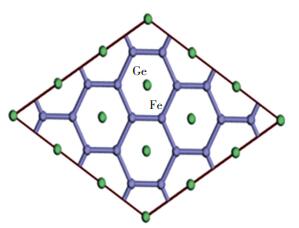
|
Fig.1 The molecular structure of Fe2Ge |
3 Results and Discussion 3.1 Relationship Between the Stress and Strain of Fe2Ge
The mechanical behavior of solids is usually defined by constitutive stress-strain relations, the stress and strain follow Hook's law if the stress is a linear function of strain. Strain ε is characterized the lattice constant along with the change of stress σ, the deformation energy[24] u as follows:
| $ u = \frac{{\frac{1}{2}\sigma \cdot {\rm{d}}y{\rm{d}}z \cdot \varepsilon \cdot {\rm{d}}x}}{{{\rm{d}}x \cdot {\rm{d}}y \cdot {\rm{d}}z}} = \frac{1}{2}\sigma \cdot \varepsilon $ |
The relationship between total energy and stress (E-S) of Fe2Ge was shown in Fig. 2. The total energy increased with the tensile stress and compressive stress increasing, the rock bottom of the E-S curve appeared at 0 GPa, the E-S curve was not symmetric to the point of 0 GPa, those varies were similar with the change of elastic potential energy, the elastic potential energy was minimum, the Fe2Ge magnetic system was the most stable under the stress of 0 GPa. The elastic potential energy is the macroscopic representation of molecular potential in the perspective of physics, the E-S curve indicates the molecules potential energy is minimum under 0 GPa, the change rate of E-S curve with compressive is less than that with tensile stress.
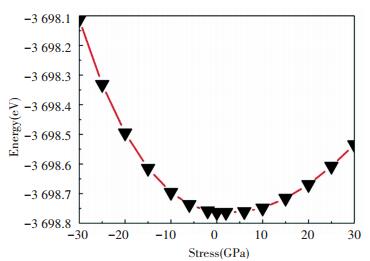
|
Fig.2 The relationship between total energy and stress of Fe2Ge |
The relationship between strain and lattice constants (L-S) of Fe2Ge was shown in Fig. 3. The strain of lattice constants of a, b and c presented the quasi linear change increased with stress increasing in the stress range of -30-0 GPa and 0-30 GPa. However, the strain change trend of lattice constants a and b are the same, differ from c, the change rate of lattice constants c is greater than lattice constants of a and b. The most significant changes occurred in the stress range of 0 and 10 GPa, the lattice constants a and b are rapidly decreased and have a turning point at 6 GPa, the lattice constant c is decreased in the stress range of 0-6 GPa and is slightly increased in the stress range of 6-10 GPa. The Poisson ratio of Fe2Ge is 0.914 22, so Fe2Ge is an elastic material. In this paper, the strain of lattice constant is changed in the range of 0- 4.382 84%, the strain is almost linearly with stress change, the stress range is in the elastic range.
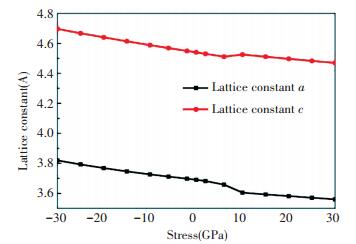
|
Fig.3 The relationship between strain and stress of Fe2Ge |
The integrated spin is defined as the difference between spin up DOS and spin down DOS, the |integrated spin| is defined as totals of spin up DOS and spin down DOS, the relationship between strain and integrated spin density (I-S) of Fe2Ge was shown in Fig. 4. |integrated spin| and integrated spin are almost linearly decreased with the stress increasing from -30 GPa to 30 GPa, this change is similar to the change of lattice constant, the results mean that the changing of lattice constant is one of the important reasons of |integrated spin| and integrated spin change. But the maximum change between the curve of I-S and the curve of L-S appeared at the stress range of 0-10 GPa, in this stress range the curve of I-S is decreased rapidly. The cause of change was a pressing need to better understand the density states changed with stressing.
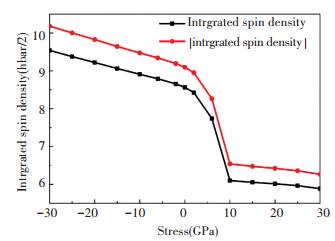
|
Fig.4 The integration spin density of Fe2Ge |
3.2 Partial Density States of Fe2Ge
The partial density of states (PDOS) of the atoms is calculated to further investigate the interaction between the Fe atom and Ge atom. The PDOS of Fe2Ge deduced from band structure calculations and PDOS of states for the Fe and Ge are presented in Fig. 5, under the stress of 0 GPa. Here, the Fermi level is taken as a reference. The Fe PDOS is dominated by the Fe 3d orbital, whereas the PDOS on Ge atoms show only small contributions from Ge(4s) and Ge(4p) orbitals. The magnetic moment is mainly dominated by the 3d orbitals of Fe atom. The structure asymmetry exists in the maximum PDOS of Fe 3d orbitals of spin-up and spin-down near the Fermi level, and the Fe 3d spin up DOS was different with the Fe-d spin down DOS, this asymmetrical spin density states represented the magnetic of Fe2Ge. In the magnetic system of Fe2Ge, the increasing energy of electron weakens the spin density of states for Fe and opposed the stability of the ferromagnetic state. Importantly, the significant difference existed in the spin-up and spin-down configuration of Ge-p, the spin states estimated came from the Ge-p electron transfer by Fe-d spin induced. The magnetic moment of Fe2Ge is computed as well and the magnetic moment about 4 μB per Fe2Ge molecule (the studied system has 2 Fe2Ge molecule). Closing to the value of 2 μB per Fe atom quoted for bulk Fe2Ge, the results correspond to Ref.[19]. The spin orbit, the charge transfer, and the orbital electric are influenced by the stress. For Fe 3d orbital, the spin up density is chiefly concentrated in -8-0 eV, the spin down density is chiefly concentrated in -5-3 eV. The Fe-d density state change on the stress range of -30 - 30 GPa was present in Fig. 6. The highest unoccupied state of spin up moves to the high energy direction, and the occupied state of spin down moves to the low energy direction in the process of the stress increasing from -30 GPa to 30 GPa, this variation depends mainly on atom characteristic in the system of Fe2Ge. When the pressure is 2 GPa and 6 GPa, the electron density varies with energy increasing which is different with the variation under other stress. This may be the main causes of the integrated spin and the lattice constant occurring significant change. For further understanding the variation characteristics of the magnetic moments with the stress changing, we analyzed the electronic characteristic and the interaction between charge and electrons from the atoms population, in Fe2Ge electronic structure system.
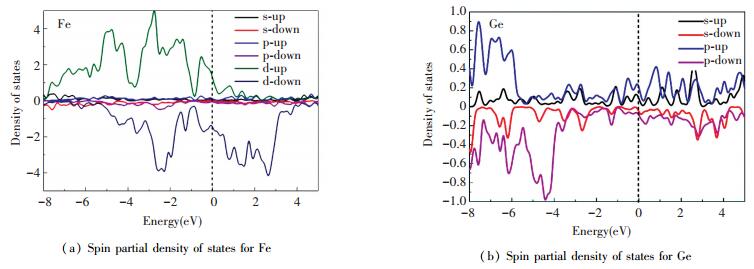
|
Fig.5 The spin partial density of states for the Fe and Ge |

|
Fig.6 The Fe-d density state change on the stress |
3.3 Atoms Population
Mulliken atomic charge calculation plays an important role in the molecular system because atomic charges affect spin electronic structure and much more electronic properties. The total atomic charges of Fe2Ge obtained by atoms population analysis, the atomic charge of Fe is increased whereas the Ge atoms is decreased, the Ge atom occupies the higher positive value in the process of the stress increasing from -30 GPa to 30 GPa. In Fig. 7, the Fe atom lost the charge, the charge transferred to the Ge atom. The amount of transferred charge for Fe is decreased, the amount of gained charge for Ge is increased. This results mean that the unevenly distributed charge formed the new occupy state and spin polarization state.
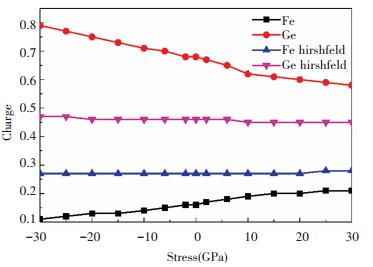
|
Fig.7 The charge population |
In the Fe2Ge electron system, the total electron of Fe more than 92% of the contribution comes from Fe 3d, the electron of Ge mainly contributes from Ge 4p and Ge 4s. Fig. 8 shows the total electron values for the Fe is decrease, for the Ge is increased in the process of the stress increasing from -30 to 30 GPa. The Fe is the electron donor, the total electron is transferred to Ge, but the total numbers of gain and lose electron is not equal. So the Fe2Ge electron system exists hybridization between the Fe 3d state and Ge 4p state, suggesting a strong s-p coupling interaction between them. Such a strong s-p interaction makes the energy levels spin split with the compressive stress increasing, this results led to the system energy of the compressive stress lower than the energy of the tensile stress (as shown in Fig. 1).
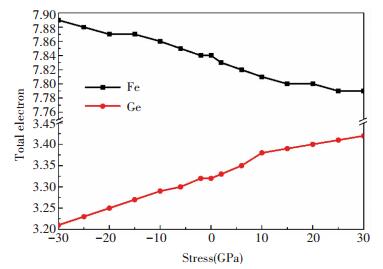
|
Fig.8 The total electron |
The Ge 4p orbital is an occupied, in nonmagnetic, the magnetic comes from the unoccupied Fe 3d orbital, but the increasing energy of electron weakens the spin density of states for Fe and opposed the ferromagnetic state, strengthens the spin density of states for Ge and applauded the ferromagnetic state. In Fig. 9, the Fe 3d is positive spin-polarization state and the spin-polarization strength is decreased, the Ge 4p is negative spin-polarization state and the spin-polarization strength is increased in the process of the stress increasing from -30 to 30 GPa. The total magnetic moment for the ferromagnetic states is very close to the expected value of 2.0 μB per Fe since the Fe 3d minority states are unoccupied. The partially filled spin-down band split off from the fully occupied spin-up band via Hund exchange. So the stress is one of the important factors for affecting the electrons-spin polarization. Moreover, electrons-spin polarization is relevant to the structure constants of the Fe2Ge system, and control spin-polarized electronic behavior by means of adjusting ferromagnetic.

|
Fig.9 The spin |
4 Conclusions
In summary, using first-principle calculations we investigated the effect of electronic structures and magnetic property of Fe2Ge by stress regulating. In this paper we consider the stress range is in the elastic range from -30 to 30 GPa, because Iron is a transitional metal, the outer shell (3d64s2) contains 3d electrons, using the method of GGA+U calculated magnetism, using a Hubbarad-U constant described the strongly correlated. The density states of Fe more than 92% contribution come from Fe 3d, the density states of Ge mainly contribute from Ge 4p and Ge 4s, and the Fe 3d spin is induced Ge 4p electron transfer by analysis of their electronic structure. The magnetic moment of Fe2Ge is computed as well and the magnetism moment is almost linearly decrease from 5 to 3 μB per Fe2Ge molecule with the stress increasing from -30 to 30 GPa. The charge of Fe is negative whereas the Ge atoms are positively charged, the Fe atom lost charge, the charge transferred to the Ge atom, the unevenly distribute charge formed the new occupy state and spin polarization state in the Fe2Ge electron structure system. But the total numbers of gain and lose electron is not equal, so the Fe2Ge electron system is exist hybridization between the Fe 3d state and Ge 4p state, the magnetic come from the unoccupied Fe 3d orbital, the Fe 3d is positive spin-polarization state and the spin-polarization strength is decrease, the Ge 4p are negative spin-polarization state and the spin-polarization strength are increase in the process of the stress increasing from -30 to 30 GPa.
| [1] |
Maafa I, Hajjar-Garreau S, Jaafar R, et al. Room-temperature ferromagnetism of all-epitaxial β-Fe-Ge/diamond-Ge/β-Fe-Ge trilayers. Journal of Physics Condensed Matter, 2013, 25(25): 256007. DOI:10.1088/0953-8984/25/25/256007 (  0) 0) |
| [2] |
Wäppling R, Häggström L, Karlsson E. Magnetic properties of FeGe studied by Mössbauer effect. Physica Scripta, 1970, 2(4-5): 233-236. DOI:10.1088/0031-8949/2/4-5/018 (  0) 0) |
| [3] |
Yu X Z, Kanazawa N, Onose Y, et al. Near room-temperature formation of a skyrmion crystal in thin-films of the helimagnet FeGe. Nature Materials, 2011, 10(2): 106-109. DOI:10.1038/nmat2916 (  0) 0) |
| [4] |
Zagrebin L D, Ivliev A D, Shabanova I N, et al. High-temperature kinetic properties of Fe-Ge solid solutions. Physics of Metals & Metallography, 2002, 94(4): 345-349. (  0) 0) |
| [5] |
Schleberger M, Walser P, Hunziker M, et al. Amorphous Fe-Si and Fe-Ge nanostructures quantitatively analyzed by x-ray-photoelectron spectroscopy. Physical Review B, 1999, 60(20): 14360. DOI:10.1103/PhysRevB.60.14360 (  0) 0) |
| [6] |
Kwon Y S, Gerasimov K B, Lomovsky O I, et al. Steady state products in the Fe-Ge system produced by mechanical alloying. Journal of Alloys and Compounds, 2003, 353(1-2): 194-199. DOI:10.1016/S0925-8388(02)01207-0 (  0) 0) |
| [7] |
Morley N A, Gibbs M R J, Fronc K, et al. Orientation and layer thickness dependence on the longitudinal magnetization and transverse magnetization hysteresis loop of sputtered multilayer Fe/Si and Fe/Ge thin films. Journal of Physics: Condens. Matter, 2004, 16(23): 4121-4130. DOI:10.1088/0953-8984/16/23/026 (  0) 0) |
| [8] |
Chun B S, Hwang C. Magnetic and electric properties of FeGe. Analytical Chemistry, 2015, 76(21): 6229-6238. (  0) 0) |
| [9] |
Golovin I S, Ivleva T V, Jäger S, et al. Structure and Anelasticity of Fe-Ge Alloys. Solid State Phenomena, 2008, 137(12): 59-68. DOI:10.4028/www.scientific.net/SSP.137.59 (  0) 0) |
| [10] |
Liu H, Zheng R K, Zhang X X. Observation of large hall sensitivity in thin Fe-Ge amorphous composite films. Journal of Applied Physics, 2005, 98(8): 086105. DOI:10.1063/1.2106016 (  0) 0) |
| [11] |
Cao M S, Yang J, Song W L, et al. Ferroferric oxide/multiwalled carbon nanotube vs polyaniline/ferroferric oxide/multiwalled carbon nanotube multiheterostructures for highly effective microwave absorption. ACS Applied Materials & Interfaces, 2012, 4(12): 6949-6956. DOI:10.1021/am3021069 (  0) 0) |
| [12] |
Sarkar S, Bansal C, Chatterjee A. Gibbs-Thomson effect innanocrystalline Fe-Ge. Physical Review B, 2000, 62(5): 3218-3222. DOI:10.1103/PhysRevB.62.3218 (  0) 0) |
| [13] |
Li W F, Li Y, Ma X L, et al. Incommensurate structure of a new Nowotny phase in Fe-Ge system. Materials Chemistry & Physics, 2014, 148(3): 490-493. DOI:10.1016/j.matchemphys.2014.08.023 (  0) 0) |
| [14] |
Liu J, Cao M S, Luo Q, et al. Electromagnetic property and tunable microwave absorption of 3D nets from nickel chains at elevated temperature. ACS Applied Materials & Interfaces, 2016, 8(34): 22615-22622. DOI:10.1021/acsami.6b05480 (  0) 0) |
| [15] |
Restorff J B, Wun-Fogle M, Hathaway K B, et al. Tetragonal magnetostriction and magnetoelastic coupling in Fe-Al, Fe-Ga, Fe-Ge, Fe-Si, Fe-Ga-Al, and Fe-Ga-Ge alloys. Journal of Applied Physics, 2012, 111(2): 023905. DOI:10.1063/1.3674318 (  0) 0) |
| [16] |
Gareev R R, Pohlmann L L, Stein S, et al. Tunneling in expitaxial Fe/Si/Fe structures with strong antiferromagnetic interlayer coupling. Journal of Applied Physics, 2003, 93(10): 8038-8040. DOI:10.1063/1.1543989 (  0) 0) |
| [17] |
Chomiuk P, Bńaszyk M, Luciński T E, et al. In Situ conductance of Fe/Si and Fe/Ge multilayers. Acta Physica Polonica Series A, 2008, 113(113): 657-662. (  0) 0) |
| [18] |
Jaafar R, Berling D, Sébilleau D, et al. Epitaxial Fe-Ge thin films on Ge(111): Morphology, structure, and magnetic properties versus stoichiometry. Physical Review B: Condensed Matter, 2010, 81(15): 155423-155429. DOI:10.1103/PhysRevB.81.155423 (  0) 0) |
| [19] |
Lou J, Daigle A, Chen L, et al. Single crystal Fe films grown on Ge (001) substrates by magnetron sputtering. Applied Physics Letters, 2006, 89(11): 1120501-1. (  0) 0) |
| [20] |
Cen W, Rong C, Yang Y, et al. The effect of (110) strain on the energy band structure and optical properties of the simple orthorhombic Ca2P0.25Si0.75 bulk. Journal of Alloys & Compounds, 2015, 629(5): 284-289. DOI:10.1016/j.jallcom.2014.10.108 (  0) 0) |
| [21] |
Cabrera A F, Sánchez F H. Mössbauer study of ball-milled Fe-Ge alloys. Physical Review B, 2002, 65(9): 094202. DOI:10.1103/PhysRevB.65.094202 (  0) 0) |
| [22] |
Kanibolotsky D S, Bieloborodova O A, Kotova N V, et al. Thermodynamics of liquid Fe-Si and Fe-Ge alloys. Journal of Thermal Analysis & Calorimetry, 2003, 71(2): 583-591. DOI:10.1023/A:1022816229045 (  0) 0) |
| [23] |
Obukuro Y, Ninomiya K, Arai M, et al. First-principles study on LaYbO3, as the localized f, electrons containing system with MBJ-LDA + U approach. Computational Materials Science, 2017, 126: 7-11. DOI:10.1016/j.commatsci.2016.09.005 (  0) 0) |
| [24] |
Ramberg W, Osgood W R. Description of Stress-Strain Curves by Three Constants. Technical Report Archive & Image Library. Washington: NASA, 1943: No.902.
(  0) 0) |
 2018, Vol. 25
2018, Vol. 25


